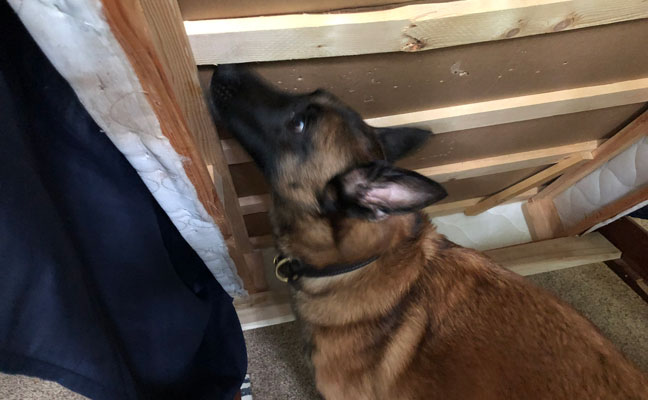
PHOTO: David Latimer
This segment continues the process of visiting a shelter and evaluating dogs for suitability as detector dogs. We’ve evaluated the dog for sociability and friendliness and it’s now time to move on to drive testing.
(Editor’s note: Read Part 1 – How to choose a dog for scent detection and Part 2 – Tips to evaluate a dog for scent detection.)
If when I bounced the ball in front of the dog’s cage it tried to grab it excitedly and showed intense focus on the ball as it bounced around, I’ll now evaluate the dog for toy drive. To do that, we’ll need an enclosed area since we have no idea whether the dog will recall if allowed off leash. After entering the enclosed area, I’ll show the dog the ball and bounce it on the ground while holding on to the dog’s collar so it can’t actually get the ball. If the dog tries to grab it, great, I’ll eventually let him do that, then offer a kibble of food or another ball to get him to release. I’ll drop the ball in front of the dog several times and observe whether the dog immediately scrambles grabs it.
Next, I’ll throw the ball several yards straight away from the dog being sure that he sees me throw it. If the dog immediately takes off toward the thrown ball, great, I’ll throw it several times to test the dog’s level of drive. I want to see the dog run after the ball time after time without losing interest. If at some point the dog stops showing interest in pursuing the ball, I’ll switch to the food drive test. If the dog continues to diligently pursue the ball energetically, every time I throw it, I’ll move on to checking whether the dog will be motivated to search for the ball.
In the next phase, I’ll have my helper hold the dog by its collar and I’ll stand just out of the dog’s reach, bouncing the ball and talking to the dog in an excited and high-pitched voice. I want to get the dog excited and struggling to get to the ball. I’ll then quickly turn away, concealing the ball and run away. I’ll act like I hide the ball in a couple of places, allowing the dog to see the ball in my hand at each place, I’ll then conceal it again and repeat this at two or three places before actually concealing it and leaving it somewhere. The goal is for the dog to not know which place I actually left the ball. I’ll then have the helper release the dog. Most dogs will immediately begin searching for the ball. If the dog finds the ball, several times in a row, I’ll move on to the next phase.
Next, I’ll evaluate what is called “hunt drive”. I’ll act like I throw the ball but actually conceal it out of the dog’s sight and not throw it. The dog must be convinced that I’ve thrown the ball or this won’t work. Upon faking the throw, the dog should run out in the direction you faked the throw and start searching. If the dog just never seems to give up searching, I’ll go do the paperwork to adopt it and start training.
In the next segment on testing dogs, we’ll evaluate a dog for food drive.
David Latimer is founder of the World Detector Dog Organization, online at WDDO.org. He can be reached at latimer_david@yahoo.com.
Leave A Comment